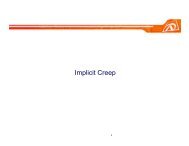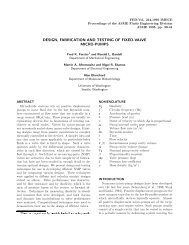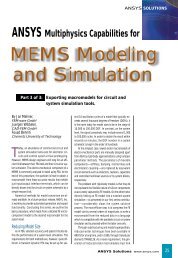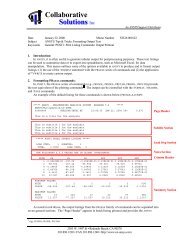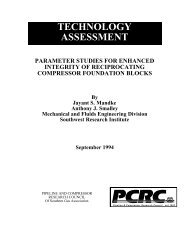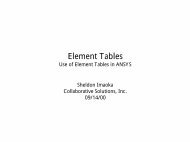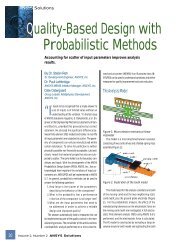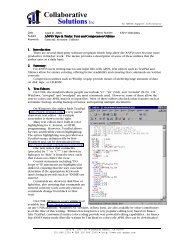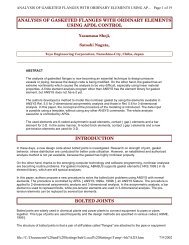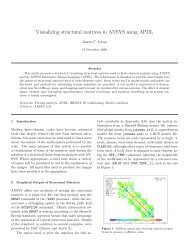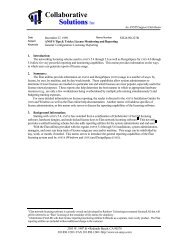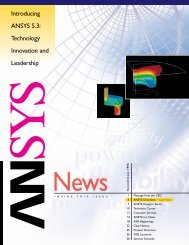anisotropic plasticity and failure prediction in wood ... - ANSYS Users
anisotropic plasticity and failure prediction in wood ... - ANSYS Users
anisotropic plasticity and failure prediction in wood ... - ANSYS Users
Create successful ePaper yourself
Turn your PDF publications into a flip-book with our unique Google optimized e-Paper software.
ANISOTROPIC PLASTICITY AND FAILURE PREDICTION IN WOOD COMPOSITES Page 4 of 22<br />
Z 13,000 6,000 620 - 10<br />
Shear Vol. (cu.<strong>in</strong>.)<br />
Avg. ultimate<br />
load (lbs.)<br />
Table 2. Shear properties of LSL based on studies by others<br />
Avg. ultimate<br />
displacement<br />
(<strong>in</strong>.)<br />
PREVIOUS MATERIAL MODELS<br />
Stress-stra<strong>in</strong> behavior<br />
Early analyses of orthotropic plates with p<strong>in</strong>-loaded holes emphasized the performance of contact elements on<br />
the boundary between the p<strong>in</strong> <strong>and</strong> the plate <strong>and</strong> assumed l<strong>in</strong>ear elastic properties for the plate (Wilk<strong>in</strong>son et al.,<br />
1981, Hyer et al., 1987). Rahman et al. (1991) performed a two-dimensional analysis of a p<strong>in</strong> <strong>in</strong> a hole <strong>in</strong> an<br />
orthotropic <strong>wood</strong> plate but added material non-l<strong>in</strong>earity due to crush<strong>in</strong>g of <strong>wood</strong> fibers to determ<strong>in</strong>e the stress<br />
distribution around the hole. They showed that a non-l<strong>in</strong>ear compression model parallel-to-gra<strong>in</strong> (with p<strong>in</strong> load<strong>in</strong>g<br />
parallel-to-gra<strong>in</strong>) resulted <strong>in</strong> improved stress <strong>prediction</strong>s along the region beg<strong>in</strong>n<strong>in</strong>g under the bolt <strong>and</strong> extend<strong>in</strong>g<br />
to the end of the specimen. These results corresponded to measured Moiré fr<strong>in</strong>ge patterns.<br />
Patton-Mallory et al. (1997) performed a non-l<strong>in</strong>ear elastic analysis <strong>in</strong> three-dimensions for a model of a s<strong>in</strong>gle<br />
bolt <strong>in</strong> a piece of Douglas fir. The geometry of this model is described <strong>in</strong> section 5. The tri-l<strong>in</strong>ear elastic stressstra<strong>in</strong><br />
behavior assumed for this model <strong>and</strong> shown <strong>in</strong> Figure 1 for normal stress parallel-to-gra<strong>in</strong>, resulted <strong>in</strong> very<br />
good load-displacement <strong>prediction</strong>s compared to experimental results. The crush<strong>in</strong>g of fibers parallel-to-gra<strong>in</strong><br />
most <strong>in</strong>fluenced the displacement of the bolt relative to the piece of <strong>wood</strong>, thus, the tri-l<strong>in</strong>ear model proved useful<br />
for load-displacement <strong>prediction</strong>s of connections. However, as was <strong>in</strong>dicated by Patton-Mallory et al. (1997),<br />
improvements are still required <strong>in</strong> the material model for <strong>wood</strong>.<br />
k<br />
No. of<br />
replicates<br />
XY - big 6.9 5054 0.07 10.6 15<br />
XY - small 3.2 2300 0.06 10.6 20<br />
YZ - big 6.8 2302 0.03 7.4 15<br />
YZ - big 3.4 1674 0.03 7.4 15<br />
XZ - small 6.8 1490 0.06 6.9 16<br />
XZ - small 3.4 701 0.06 6.9 14<br />
Poisson's Ratios Value<br />
No. of<br />
replicates<br />
XY 0.048 10<br />
YZ 0.993 10<br />
XZ 0.351 10<br />
Interlam<strong>in</strong>ar Shear<br />
G YZ parallel (psi) 61,000<br />
G XZ perpendicular (psi) 26,000<br />
Edgewise Shear<br />
G XY (psi) 200,000<br />
file://C:\Documents%20<strong>and</strong>%20Sett<strong>in</strong>gs\beh\Local%20Sett<strong>in</strong>gs\Temp\~hhC936.htm<br />
7/9/2002



